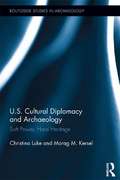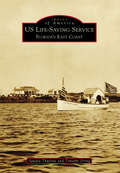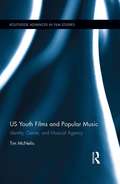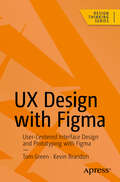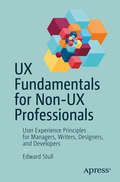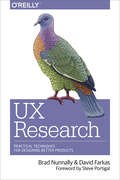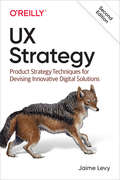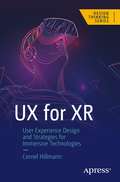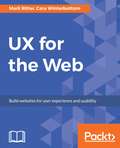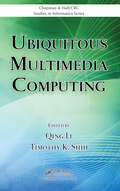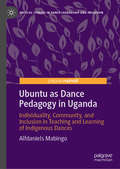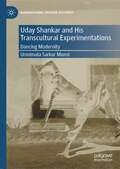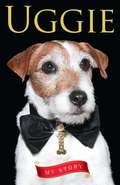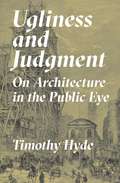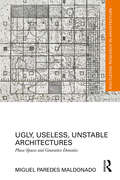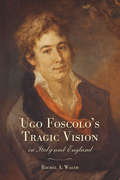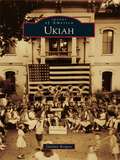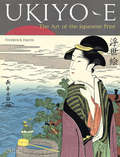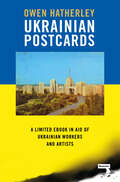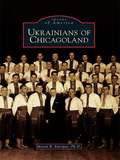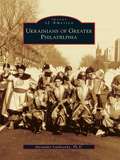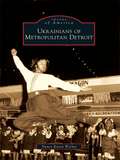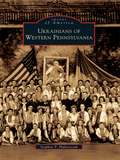- Table View
- List View
US Cultural Diplomacy and Archaeology: Soft Power, Hard Heritage (Routledge Studies in Archaeology)
by Christina Luke Morag KerselArchaeology’s links to international relations are well known: launching and sustaining international expeditions requires the honed diplomatic skills of ambassadors. U.S. foreign policy depends on archaeologists to foster mutual understanding, mend fences, and build bridges. This book explores how international partnerships inherent in archaeological legal instruments and policies, especially involvement with major U.S. museums, contribute to the underlying principles of U.S. cultural diplomacy. Archaeology forms a critical part of the U.S. State Department’s diplomatic toolkit. Many, if not all, current U.S.-sponsored and directed archaeological projects operate within U.S. diplomatic agendas. U.S. Cultural Diplomacy and Archaeology is the first book to evaluate museums and their roles in presenting the past at national and international levels, contextualizing the practical and diplomatic processes of archaeological research within the realm of cultural heritage. Drawing from analyses and discussion of several U.S. governmental agencies’ treatment of international cultural heritage and its funding, the history of diplomacy-entangled research centers abroad, and the necessity of archaeologists' involvement in diplomatic processes, this seminal work has implications for the fields of cultural heritage, anthropology, archaeology, museum studies, international relations, law, and policy studies.
US Life-Saving Service: Florida's East Coast (Images of America)
by Sandra Thurlow Timothy DringTen houses of refuge, unique to Florida's east coast, were constructed by the US Life-Saving Service between 1876 and 1886. When ships traveling along the almost uninhabited coast were grounded or wrecked on reefs, survivors often made it to land but had no way to reach civilization. House of refuge keepers and their families provided food and shelter to victims of shipwrecks. The keepers' lives were monotonous but punctuated with the excitement of an occasional shipwreck. The US Life-Saving Service provided the framework on which the east coast of Florida developed. With the establishment of the US Coast Guard in 1915, the Life-Saving Service houses of refuge became Coast Guard stations.
US Youth Films and Popular Music: Identity, Genre, and Musical Agency (Routledge Advances in Film Studies)
by Tim McNelisThis book brings theory from popular music studies to an examination of identity and agency in youth films while building on, and complementing, film studies literature concerned with genre, identity, and representation. McNelis includes case studies of Hollywood and independent US youth films that have had commercial and/or critical success to illustrate how films draw on specific discourses surrounding popular music genres to convey ideas about gender, race, ethnicity, sexuality, and other aspects of identity. He develops the concept of ‘musical agency’, a term he uses to discuss the relationship between film music and character agency, also examining the music characters listen to and discuss, as well as musical performances by the characters themselves
UX Design with Figma: User-Centered Interface Design and Prototyping with Figma (Design Thinking)
by Tom Green Kevin BrandonMaximize Figma’s arsenal of tools and plugins within a team-based collaborative environment and accelerate your company’s decision making. This book will show you where Figma fits into the user experience (UX) design process from documentation to developer handoff. Since its release as a browser-based design tool in 2016, Figma has fast become the de facto UX Design tool for the industry mainly due to its accessibility and ease of use. As you move through the book you will learn where Figma fits in the UX process. For example, using FigJam (an online whiteboard) for brainstorming, and creating interactive prototypes for mobile devices, tablets, and web sites. You’ll also see how Figma is used to create and integrate with design systems, and how variables, when applied to design system components, can accelerate the design and development workflow. With the help of step-by-step examples, and using Figma’s tools and templates, you’ll create artifacts such as Flow and Journey diagrams, Personas, and wireframes. From there you will explore other design and interactivity features, and how to prepare a Figma file for handoff to a development team. This book is your roadmap to utilizing Figma, the industry’s fastest growing collaborative design tool for building meaningful products. What You Will Learn Create interactive prototypes Test and submit designs for team review Understand the collaborative workflow involved in an UX project Prepare common UX documentation Who This Book Is For Designers, developers, and UX specialists with little-to-no Figma experience who are looking to integrate it within their workflows, and intermediate Figma users who are just starting to become involved in the collaborative UX workflow.
UX Fundamentals for Non-UX Professionals: User Experience Principles for Managers, Writers, Designers, and Developers
by Edward StullDemystify UX and its rules, contradictions, and dilemmas. This book provides real-world examples of user experience concepts that empower teams to create compelling products and services, manage social media, interview UX candidates, and oversee product teams.From product decisions to performance reviews, your ability to participate in discussions about UX has become vital to your company's success as well as your own. However, UX concepts can seem complex. Many UX books are written by and for UX professionals. UX Fundamentals for Non-UX Professionals serves the needs of project managers, graphic designers, copyeditors, marketers, and others who wish to understand UX design and research.You will discover how UX has influenced history and continues to affect our daily lives. Entertaining real-world examples demonstrate what a massive, WWII-era tank teaches us about design, what a blue flower tells us about audiences, and what drunk marathoners show us about software.What You'll LearnKnow the fundamentals of UX through real-world examples Acquire the skills to participate intelligently in discussions about UX design and researchUnderstand how UX impacts business, including product, pricing, placement, and promotion as well as security, speed, and privacyWho This Book Is ForProfessionals who work alongside UX designers and researchers, including but not limited to: project managers, graphic designers, copyeditors, developers, and human resource professionals; and business, marketing, and computer science students seeking to understand how UX affects human cognition and memory, product pricing and promotion, and software security and privacy.
UX Research: Practical Techniques for Designing Better Products
by Brad Nunnally David FarkasOne key responsibility of product designers and UX practitioners is to conduct formal and informal research to clarify design decisions and business needs. But there’s often mystery around product research, with the feeling that you need to be a research Zen master to gather anything useful. Fact is, anyone can conduct product research. With this quick reference guide, you’ll learn a common language and set of tools to help you carry out research in an informed and productive manner.This book contains four sections, including a brief introduction to UX research, planning and preparation, facilitating research, and analysis and reporting. Each chapter includes a short exercise so you can quickly apply what you’ve learned.Learn what it takes to ask good research questionsKnow when to use quantitative and qualitative research methodsExplore the logistics and details of coordinating a research sessionUse softer skills to make research seem natural to participantsLearn tools and approaches to uncover meaning in your raw dataCommunicate your findings with a framework and structure
UX Strategy: How To Devise Innovative Digital Products That People Want
by Jaime LevyUser experience (UX) strategy lies at the intersection of UX design and business strategy, but until now, there hasn't been an easy-to-apply framework for executing it. This hands-on guide introduces lightweight product strategy tools and techniques to help you and your team devise innovative digital solutions that people want.Author Jaime Levy shows UX/UI designers, product managers, entrepreneurs, and aspiring strategists simple to advanced methods that can be applied right away. You'll gain valuable perspective through business cases and historical context. This second edition includes new real-world examples, updated techniques, and a chapter on conducting qualitative online user research.Define value propositions and validate target users through provisional personas and customer discovery techniquesExplore marketplace opportunities by conducting competitive research and analysisDesign experiments using rapid prototypes that are focused on the business modelConduct online user research to gain valuable insights quickly on any budgetTest business ideas and validate marketing channels by running online advertising and landing page campaigns
UX for XR: User Experience Design and Strategies for Immersive Technologies (Design Thinking)
by Cornel HillmannExtending traditional digital platforms to the new frontier of extended reality (XR) requires taking into account what best practices, new concepts, and conventions have been established and what learnings can be brought forward from case studies involving industry leaders. By looking at practical examples from the field of handheld AR breakthroughs, virtual reality (VR) success stories and experimental interaction concept of pioneering XR platforms, you'll see how it's possible to map out a framework of user experience (UX) guidelines to close in on opportunities and challenges that lay ahead.This book defines, identifies, and analyzes UX practices for XR environments and reviews the techniques and tools for prototyping and designing XR user interactions. You'll approach the design for experiential state and spatial cognition, using established UX key performance indicators, while taking into account the social dynamics, emotional framework and wider industry context.UX design and strategy for the XR space is a new frontier, so UX for XR focuses on case studies and industry research to illustrate the relationship between UX design and the growth of immersive technologies. Practical examples will demonstrate how you should apply UX design principles using designing interactions in XR by identifying the importance of spaces, senses and storyboarding.What You'll LearnExplore the challenges and opportunities of designing for XRSee how spatial interaction is revolutionizing human computer interactionExamine sensory input and interaction beyond the screenWork with 3D Interaction Design and build a strong 3D UXUnderstand VR and augmented reality essentials for emotion-rich user experiencesApply UX research techniques for the XR spaceWho This Book Is ForThis book is primarily for UX designers, consultants, and strategists; XR developers; and media professionals
UX for the Web
by Marli Ritter Cara WinterbottomLearn how UX and design thinking can make your site stand out from the rest of the internet. About This Book • Learn everything you need to know about UX for your Web Design. • Design B2B, B2C websites that stand out from the competitors with this guide • Enhance your business by improving customer accessibility and retention. Who This Book Is For If you're a designer, developer, or just someone who has the desire to create websites that are not only beautiful to look at but also easy to use and fully accessible to everyone, including people with special needs, UX for the Web will provide you with the basic building blocks to achieve just that. What You Will Learn • Discover the fundamentals of UX and the User-Centered Design (UCD) Process. • Learn how UX can enhance your brand and increase user retention • Learn how to create the golden thread between your product and the user • Use reliable UX methodologies to research and analyze data to create an effective UX strategy • Bring your UX strategy to life with wireframes and prototypes • Set measurable metrics and conduct user tests to improve digital products • Incorporate the Web Content Accessibility Guidelines (WCAG) to create accessible digital products In Detail If you want to create web apps that are not only beautiful to look at, but also easy to use and fully accessible to everyone, including people with special needs, this book will provide you with the basic building blocks to achieve just that. The book starts with the basics of UX, the relationship between Human-Centered Design (HCD), Human-Computer Interaction (HCI), and the User-Centered Design (UCD) Process; it gradually takes you through the best practices to create a web app that stands out from your competitors. You'll also learn how to create an emotional connection with the user to increase user interaction and client retention by different means of communication channels. We'll guide you through the steps in developing an effective UX strategy through user research and persona creation and how to bring that UX strategy to life with beautiful, yet functional designs that cater for complex features with micro interactions. Practical UX methodologies such as creating a solid Information Architecture (IA), wireframes, and prototypes will be discussed in detail. We'll also show you how to test your designs with representative users, and ensure that they are usable on different devices, browsers and assistive technologies. Lastly, we'll focus on making your web app fully accessible from a development and design perspective by taking you through the Web Content Accessibility Guidelines (WCAG). Style and Approach This is an easy-to-understand step-by-step guide with full of examples to that will help you in creating good UX for your web applications.
Ubiquitous Multimedia Computing (Chapman & Hall/CRC Studies in Informatics Series)
by Qing Li Timothy K. ShinComputing is ubiquitous and if you think otherwise, that in itself might be the best evidence that it is so. Computers are omnipresent in modern life and the multimedia computing environment of today is becoming more and more seamless.Bringing together contributions from dozens of leading experts, Ubiquitous Multimedia Computing educates readers on
Ubuntu as Dance Pedagogy in Uganda: Individuality, Community, and Inclusion in Teaching and Learning of Indigenous Dances (Critical Studies in Dance Leadership and Inclusion)
by Alfdaniels MabingoThis book locates the philosophy of Ubuntu as the undergirding framework for indigenous dance pedagogies in local communities in Uganda. Through critical examination of the reflections and practices of selected local dance teachers, the volume reveals how issues of inclusion, belonging, and agency are negotiated through a creatively complex interplay between individuality and communality. The analysis frames pedagogies as sites where reflective thought and kinaesthetic practice converge to facilitate ever-evolving individual imagination and community innovations.
Uday Shankar and His Transcultural Experimentations: Dancing Modernity (Transnational Theatre Histories)
by Urmimala Sarkar MunsiThis monograph presents a specific experience of modernity within the context of Indian dance by looking at the transcultural journey of Indian dancer / choreographer Uday Shankar (1900b – 1977d). His popularity in Europe and America as an Oriental male dancer in the first half of the 20th century, and his worldwide recognition as the Ambassador of Indian culture, are brought into a historiographical perspective within the cultural and social reforms of early twentieth century India. By exploring his artistic journey beyond India in the period between the two world wars, and his experience of dance making, presentational technique and representation of India through various phases of his life, a path is forged to understanding the emergence of modernity in Indian dance.
Uggie--My Story: My Story
by UggieA heartwarming memoir by the Jack Russell Terrier that starred in The Artist and Water for Elephants.Uggie&’s memoir offers readers the true rags-to-riches tale of one ordinary Jack Russell Terrier who made it big in Hollywood. For the first time, Uggie tells his story of rising from humble beginnings as an abandoned shelter dog to being adopted by esteemed trainer Omar Von Muller. Uggie details his time starring in commercials for everything from Kia cars to Bud Light. Uggie eventually broke into the film world with his appearance in Mr. Fixit in 2006. He went on to appear in Wassup Rockers and Life is Ruff. Uggie got his first serious film role in 2011's Water for Elephants where he starred alongside Reese Witherspoon and Robert Pattinson. It was not, however, until 2012's The Artist that Uggie really dazzled audiences with his talents. In his memoir, Uggie will talk about life on the set of the Oscar-winning film and the role that many said should have earned him an Oscar. Uggie's memoir doesn't just hit on his career highlights, it also takes a candid look at his his private demons: overcoming a painful past as a cat-murderer and finding redemption; living with shaking syndrome; his regret at never siring any pups before being neutered. Uggie's memoir will include not just biographical information, but also advice from the dog himself. As is seen in his dazzling performance in The Artist, Uggie is an incredibly talented performer. He honed his craft while touring South America each year as part of The Incredible Dog Show, and in his memoir, he will spend several chapters sharing practical training and dieting tips that he has developed over the years.
Ugliness and Judgment: On Architecture in the Public Eye
by Timothy HydeA novel interpretation of architecture, ugliness, and the social consequences of aesthetic judgmentWhen buildings are deemed ugly, what are the consequences? In Ugliness and Judgment, Timothy Hyde considers the role of aesthetic judgment—and its concern for ugliness—in architectural debates and their resulting social effects across three centuries of British architectural history. From eighteenth-century ideas about Stonehenge to Prince Charles’s opinions about the National Gallery, Hyde uncovers a new story of aesthetic judgment, where arguments about architectural ugliness do not pertain solely to buildings or assessments of style, but intrude into other spheres of civil society.Hyde explores how accidental and willful conditions of ugliness—including the gothic revival Houses of Parliament, the brutalist concrete of the South Bank, and the historicist novelty of Number One Poultry—have been debated in parliamentary committees, courtrooms, and public inquiries. He recounts how architects such as Christopher Wren, John Soane, James Stirling, and Ludwig Mies van der Rohe have been summoned by tribunals of aesthetic judgment. With his novel scrutiny of lawsuits for libel, changing paradigms of nuisance law, and conventions of monarchical privilege, he shows how aesthetic judgments have become entangled in wider assessments of art, science, religion, political economy, and the state.Moving beyond superficialities of taste in order to see how architectural improprieties enable architecture to participate in social transformations, Ugliness and Judgment sheds new light on the role of aesthetic measurement in our world.
Ugly, Useless, Unstable Architectures: Phase Spaces and Generative Domains (Routledge Research in Architecture)
by Miguel Paredes MaldonadoUgly, Useless, Unstable Architectures traces productive intersections between architecture and the discourses of Post-Structuralism and New Materialism. It investigates how their unique ‘ontological regimes’ can be mobilised to supersede the classical framework that still informs both the production and the evaluation of architecture. Throughout its three main chapters, this enquiry challenges one of the most prevalent tropes of architectural assessment: Beauty, Utility and Stability. Author Miguel Paredes Maldonado critically unpacks the spatial and operational qualities of these three idealised concepts, before setting out an alternative framework of spatial practice that draws from Gilles Deleuze’s post-structuralist take on the production of the real and Manuel DeLanda’s model-based branch of New Materialism. This book reads and situates a series of spatial works through the lens of this critical methodology to contest the conceptual aspects traditionally underpinning architectural ‘value’. It posits that architecture can operate as a continuous, generative spectrum encompassing a broad range of potential configurations. Written for academics and students in architectural theory, design and contemporary philosophical thought alike, this book should appeal to a wide audience.
Ugo Foscolo's Tragic Vision in Italy and England
by Rachel A. WalshOne of the most celebrated Italian writers of the early Romantic period, Ugo Foscolo (1778-1827) was known primarily as a novelist, a poet, and a nationalist. Following the Napoleonic Wars, he lived in self-exile in England during the last decade of his life. There he wrote numerous critical essays and collaborated with Lord Byron and other well-known members of English literary circles.Ugo Foscolo's Tragic Vision in Italy and England examines an underexplored aspect of Foscolo's literary career: his tragic plays and critical essays on that genre. Rachel A. Walsh argues that for Foscolo tragedy was more than another genre in which to exercise his literary ambitions. It was the medium for an elaborate life-long process of self-examination and engagement with political and literary conflict. By analysing Foscolo's tragic struggles on and off the stage, Walsh sheds new light on his career and how it reflects on the important literary and political trends of the time.
Ukiah (Images of America)
by Darline BergereNestled in the Yokayo Valley, surrounded by coastal ranges, Ukiah officially became a town in 1859 when it broke away from being governed by Sonoma County. Spanish settlers put down roots through land grants and brought their rich culture to the area. Pomo Indians who lived in Ukiah wove baskets, which are collectors' items today throughout the world. Vichy Springs Resort, built in the mid-1800s on the outskirts of Ukiah, had many notable visitors, including Presidents Grant and Harrison, Mark Twain, Robert Lewis Stevenson, and Jack London. Today Ukiah is a city where people still ride their bicycles, and the high school has a homecoming parade before the big game. Farmers, ranchers, and vineyard owners work side by side. Summer months bring the annual Sunday in the Park free concerts, and the area is home to an active performing-arts community as well as several art galleries.
Ukiyo-e
by Frederick HarrisUkiyo-e ("pictures of the floating world") is an art form that originated in the metropolitan culture of Edo (Tokyo) in the early seventeenth century and involved collaboration between artist, carver, printer and publisher. Printed on fragile paper using a technique of woodcut or woodblock printing, the early black and white designs soon gave way to delicate two-color prints and then to multicolored prints. Favorite subjects were portraits of beautiful geisha and courtesans, popular kabuki actors and sumo wrestlers, erotica, scenes from nature, historical subjects and even foreigners in Japan.The charming, carefully selected ukiyo-e in this book reflect not only Japan's rich history and way of life but also reveal the author's love affair with an art form that has captured the imagination of people all over the world.
Ukiyo-e
by Frederick HarrisUkiyo-e ("pictures of the floating world") is an art form that originated in the metropolitan culture of Edo (Tokyo) in the early seventeenth century and involved collaboration between artist, carver, printer and publisher. Printed on fragile paper using a technique of woodcut or woodblock printing, the early black and white designs soon gave way to delicate two-color prints and then to multicolored prints. Favorite subjects were portraits of beautiful geisha and courtesans, popular kabuki actors and sumo wrestlers, erotica, scenes from nature, historical subjects and even foreigners in Japan.The charming, carefully selected ukiyo-e in this book reflect not only Japan's rich history and way of life but also reveal the author's love affair with an art form that has captured the imagination of people all over the world.
Ukiyo-e
by Frederick HarrisThe art of Japanese woodblock printing, known as ukiyo-e ("pictures of the floating world"), reflects the rich history and way of life in Japan hundreds of years ago. Ukiyo-e: The Art of the Japanese Print takes a thematic approach to this iconic Japanese art form, considering prints by subject matter: geisha and courtesans, kabuki actors, sumo wrestlers, erotica, nature, historical subjects and even images of foreigners in Japan.An artist himself, author Frederick Harris--a well-known American collector who lived in Japan for 50 years--pays special attention to the methods and materials employed in Japanese printmaking. The book traces the evolution of ukiyo-e from its origins in metropolitan Edo (Tokyo) art culture as black and white illustrations, to delicate two-color prints and multicolored designs. Advice to admirers on how to collect, care for, view and buy Japanese ukiyo-e woodblock prints rounds out this book of charming, carefully selected prints.
Ukrainian Postcards: A Limited Ebook in Aid of Ukrainian Workers and Artists
by Owen HatherleyAn ebook on the threatened built environment of urban Ukraine, with all proceeds going to the CWU's Ukraine fund and Artists at Risk.This is a short, limited edition ebook, with all proceeds being divided between the Communication Workers Union's Humanitarian Fund for Ukraine, and Artists at Risk's Ukraine appeal. Today, during Russia's imperialist war on Ukraine, everyone is talking about this large, beautiful and multicultural country, but, when doing so, they're often repeating some poorly understood cliches and myths. Ukrainian Postcards, written firmly from the political left, draws on the author's writings on the modern architecture of various Ukrainian cities, written between 2010 and 2020, to build up a picture of a country that could one day be a model of how to live with a difficult past and a multicultural present - but which has been consistently undermined by politicians who use it as a cashbox and, above all, a neighbour who uses it as punchbag.Above all, at a time when Ukraine's architectural heritage is literally under threat — shelled and bombed by the Russian air force, day-in-day-out — it outlines just how valuable and special this country's buildings are, and how much we stand to lose with their destruction.
Ukrainians of Chicagoland
by Myron B. KuropasUkrainians arrived in Chicagoland in four distinct waves: 1900-1914, 1923-1939, 1948-1956, and 1990-2006. At the beginning of the 20th century, immigrants from Ukraine came to Chicago seeking work, and in 1905, a Ukrainian American religio-cultural community, now officially named Ukrainian Village, was formally established. Barely conscious of their ethnonational identity, Ukraine's early immigrants called themselves Rusyns (Ruthenians). Thanks to the socio-educational efforts of Eastern-rite Ukrainian Catholic and Orthodox priests, some Rusyns began calling themselves Ukrainians, developing a distinct national identity in concert with their brethren in Ukraine.
Ukrainians of Greater Philadelphia (Images of America)
by Alexander LushnyckyUkrainians, originally known as Ruthenians, began arriving in the Philadelphia area at the end of the 1800s. Like all immigrants, they were not spared considerable hardships in their pursuit of the American dream. Finding stable employment was an ongoing endeavor. After work they gathered around their churches, indisputably the centerpiece of their immigrant communities. Here they procured much-needed support from their fellow countrymen. Theirs was a common purpose: to preserve in this new world their cherished customs and traditions. Thus their societies abounded with schools, choirs, bands, dance groups, reading rooms, and church and fraternal organizations. With time, more Ukrainians appeared, with the largest group arriving after World War II to escape the horrors of war-torn Europe and start anew. Ukrainians of Greater Philadelphia documents how each new generation of immigrants added to the kaleidoscope that became the Ukrainian community in and around the City of Brotherly Love.
Ukrainians of Metropolitan Detroit
by Nancy Karen WicharUkrainians have contributed to the diverse ethnic tapestry in Detroit since the arrival of the first Ukrainian immigrants in the late 1800s. Bringing their history, culture, and determination to achieve, they established a foundation for the resilient community that would continue to emerge during the decades to come. Ukrainian neighborhoods formed on both the east and west sides of the city. This is where they constructed the churches, schools, cultural centers, and financial institutions that would allow them to maintain their cherished ethnic identity while integrating into the American way of life. This book is a pictorial history of the people and events that created a community that would come to be known as the Ukrainians of metropolitan Detroit.
Ukrainians of Western Pennsylvania
by Stephen P. HaluszczakOriginally known as Ruthenians, Ukrainians began to immigrate to western Pennsylvania in the late 1800s. Attracted by the region's growing importance as an industrial center, they settled in cities and towns close to their work. Like other immigrants, they faced many economic and social hardships, but they were proud to call themselves Americans as they firmly preserved and celebrated their ethnic heritage. Their dispersion among the hills and valleys of western Pennsylvania prevented the development of a highly centralized community, but it also preserved many of the unique aspects of a diverse people. Ukrainians of Western Pennsylvania chronicles where these hardworking people settled, the ways they organized community and personal life, the venues through which they presented their heritage, their contributions to the general community, and how their community has grown with the times.
